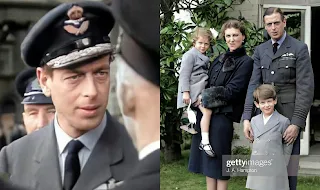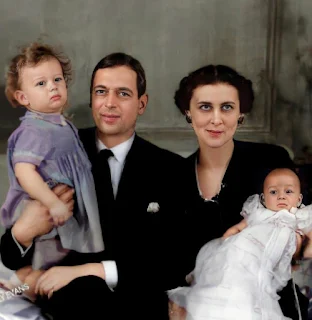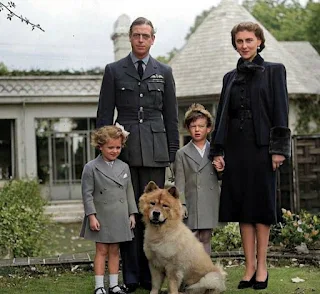Today is the 80th death anniversary of HRH Prince George, Duke of Kent. He was Queen Elizabeth II's paternal uncle, and the father of Prince Edward, the Duke of Kent, Princess Alexandra, and Prince Michael.
His tragic death still haunted the royal world, not only the Duke had died at such a young age (39), and just eight years into his marriage, his sudden demise still remained a mystery. The circumstances surrounding his death were never fully explained.
 |
| Prince George, Duke of Kent |
And if there was an investigation following the plane crash, the details were not fully divulged to the public, and the documents related to the tragedy were either lost or locked up in the royal archive in Windsor Castle.
 |
| Prince George, Duke of Kent |
What really happened on the fateful sunny day of August 25, 1942, when Prince George was heading on a special mission?
The Duke's life
His Royal Highness, Prince George, Duke of Kent, was born on December 20, 1902, at York Cottage in Sandringham, Norfolk. He was the fourth son of King George V and Queen Mary and had five siblings: Edward VIII, George VI, Prince Henry, Duke of Gloucester, Princess Mary, and Prince John.
At the time of his birth, he was 5th in the line of succession to the British throne. On November 29, 1934, he married his second cousin (through King Christian IX of Denmark), Princess Marina of Greece and Denmark, the granddaughter of King George I of Greece, and first cousin of Prince Philip (later Duke of Edinburgh).
Princess Marina was the daughter of Prince Nicholas of Greece and Denmark (older brother of Prince Andrew of Greece and Denmark) and Grand Duchess Elena Vladimirovna of Russia, granddaughter of Tsar Alexander II of Russia.
The Duke's special mission
The Duke of Kent was a Royal Navy Officer before he transferred to the Royal Airforce. He eventually became a Group Captain in the Royal Air Force and Air Vice-Marshal and was an active military officer during World War II.
On August 25, 1942, Prince George was scheduled to visit the Royal Air Force personnel stationed in Iceland as part of his military duty during World War II. He and his companions were assigned to board a flying boat bomber, RAF S-25 Sunderland MK III.
 |
| Prince Edward was only six years old when his father died in 1942 |
And because the flight would be carrying a royal prince who was 6th in line of succession to the British throne, the crew and companions were carefully selected.
The captain, Flight Lieutenant Frank Goyen, was considered an expert to fly a flying boat bomber. The co-pilot was the commanding officer of 228 Squadron, Wing Commander, Thomas Lawton Mosley, one of RAF’s most experienced pilots. Accompanying the prince were his private secretary, equerry, and valet.
According to Military History, that type of plane was great in many ways, however, considered "severely underpowered for its size," meaning it would work best only when flying over water than inland.
For that reason, the journey to Iceland was set to fly over the ocean rather than land. However, for unknown reasons (due to lack of existing documentation), the pilot went off course toward the land, which was against the standing orders.
The flying boat bomber took off in Invergordon, Scotland on a sunny day on August 25, 1942, but after 32 minutes in the air, it exploded and crashed on the hillside of Caithness.
The Duke of Kent was the first royal prince to die on active military service since King James IV of Scotland (who was killed during the Battle of Flodden in 1513).
His death came as a shock because it was the first major tragedy in the British royal family during World War II, involving a direct relative of the reigning king.
Mysterious Death
His tragic death from a plane crash at the age of 39 raised speculations of a conspiracy theory due to several misleading pieces of information provided to the public.
The circumstances of his death and details on why the plane had crashed despite the sunny weather were never fully explained leading to a suspicion that somewhere, somehow there was a cover-up.
When the investigation began, the tragedy raised many questions. Why did the pilot maneuver the plane over the land when it was a flying boat bomber that was supposed to fly over the water?
Why did the pilot make a descent to some 650 feet when he was flying over Highland? Was there any problem on the aircraft or engine?
These questions were never answered during the investigation, or if ever there were answers, the details were not shared publicly.
When the investigators reached the crash site, 14 bodies were recovered including the Duke of Kent. In his position was a suitcase strapped on his wrist containing hundred kroner (A Swedish currency) notes.
No explanation could support this circumstance why the Duke brought notes not valid in his country of destination.
Theory of the tragedy
The only survivor in the tragedy was Flight Sergeant, Andrew Jack, the tail gunner who occupied the tail end of the aircraft. He was separated from the group when it blew off and flung to the other side of the hills.
Andy Jack suffered severe burns when he was found by a local. He remained in the hospital, traumatized from the tragedy, for several weeks.
Surprisingly, he refused to say anything about the accident. His refusal to speak and his silence brought more confusing angles related to the tragedy.
Jack was not heard actively cooperating in the investigation and he barely spoke about the tragedy. According to news releases, it was because he was under an oath not to speak anything.
There were theories that emerged after the incident. Jack's niece claimed that Jack told his brother that Prince George had been at the controls of the plane; that Jack had dragged him from the pilot's seat after the crash; and that there was an additional person on board the plane whose identity has never been revealed.
However, those speculations were never confirmed publicly by Andrew Jack.
Prince George's widow, Princess Marina, Duchess of Kent, was known to have contacted Andrew Jack on several occasions, but details of their conversations or meeting were not divulged in public.
The only explanation established at the time of Prince George's death was that he was heading on a special mission in Iceland, but details of that “special mission” were never fully explained.
Princess Marina was only 35 at the time of her husband's death. She continued to perform official royal duties following widowhood. She attended the wedding of her first cousin, Prince Philip to her husband's niece, Princess Elizabeth, in 1947.
Princess Marina died on August 27, 1968, at Kensington Palace, two days after the 26th death anniversary of her husband, due to a brain tumor. Her funeral was the last royal event attended by her brother-in-law, The Duke of Windsor (formerly Edward VIII).
Now, 80 years after the tragedy, Prince George's death remained an unsolved mystery. None among the British royal family members have ever publicly spoken about the incident.
Today, two of Prince George's children are working members of the British royal family: Prince Edward, the Duke of Kent, and Princess Alexandra.



















0 Comments